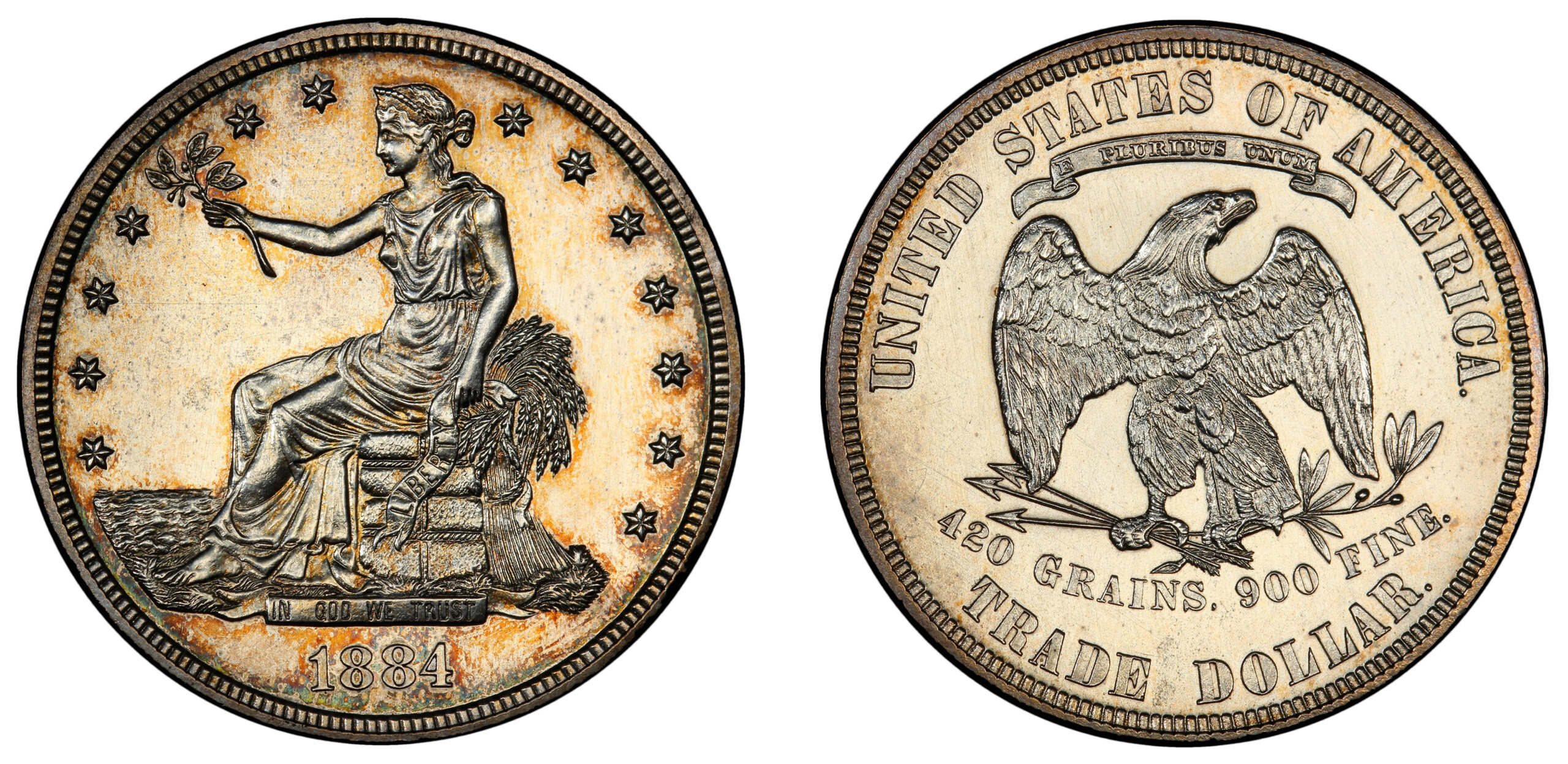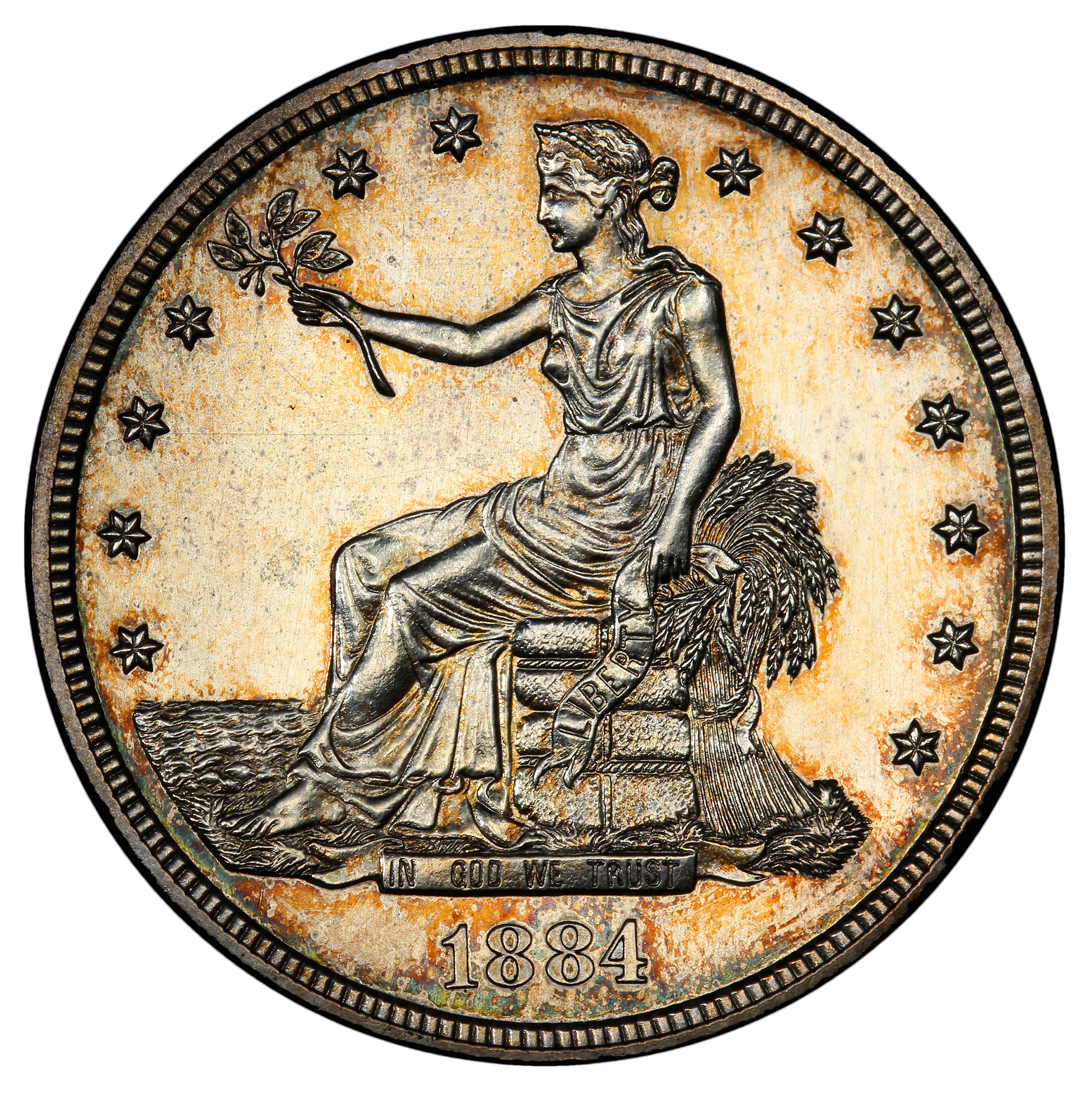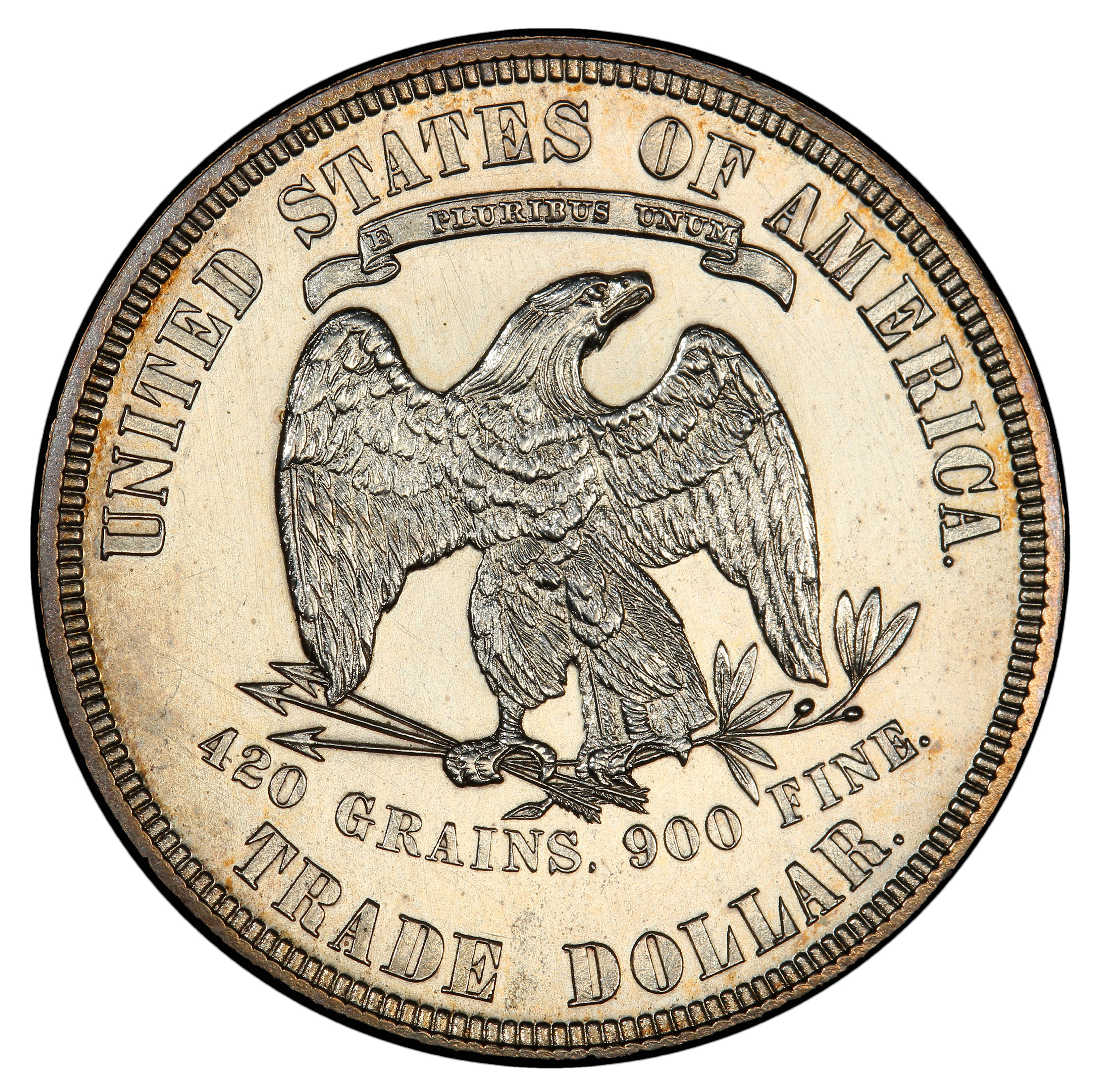
Coin Snapshot
- Weight: 27.20 Grams
- Composition: 90% silver, 10% copper
- Diameter: 38.10 mm
- Thickness: 2.40 mm
- Years Minted: 1873 – 1885
- Designed by: William Barber
The Trade Dollar was introduced to the world by the United States via the Coinage Act of 1873 and went into production soon thereafter. Unlike a majority of other silver dollars coins minted by the United States Government, Trade Dollars were never intended to be used as circulating coinage by citizens – instead they were meant to serve as a form of quasi-currency to be used for trading with Asian countries in the late 19th century. In fact, during it’s first year of production in 1873, most of the Trade Dollar coins that were struck were sent to China.
Though business strike variations of the Trade Dollar coin were minted from 1873 through 1878, proof coins were struck up until 1885. The history of the Trade Dollar as legal tender coinage is a bit complicated, as it was demonetized by the United States Government in 1876 but was struck through 1885. Though many other, more popular silver coins came onto the scene during that time period (such as the Morgan Dollar), Trade Dollars continued to be used by many people through the late 19th century.
What is a “Trade Coin”
Trade Coins have been used off and on throughout history as a means of trading between countries. They are typically minted by a government, country or territory and are similar in appearance to coins – however they hold no legal tender value in the country where they were minted. Essentially, a trade coin is a “bullion coin” – since it is exchanged between countries based on the intrinsic value of the metal they contain. They were used by a variety of countries throughout the 18th and 19th centuries. The trade dollar is just one example of a trade coin, while other popular examples include the Maria Theresa Thaler (Austria),
Trade Dollar Coin Design
Several engravers and artists of the time submitted design proposals for the Trade Dollar however both the obverse and reverse that were designed by William Barber were chosen to be used.
Obverse Design

The obverse design of the United States Trade Dollar stands as a testament to the nation’s aspirations for global economic engagement during the late 19th century. Crafted by William Barber, the Chief Engraver of the United States Mint, the obverse features an intricate depiction of Lady Liberty. Adorned with a coronet inscribed with the word “LIBERTY,” she gazes resolutely into the distance, symbolizing the nation’s forward-looking vision and commitment to commerce.
The intricate details of Lady Liberty’s attire further reflect the coin’s intended purpose as a symbol of American economic prowess on the international stage. Draped in a flowing gown, she holds a sheaf of wheat and a bundle of cotton, emblematic of the agricultural abundance that fueled the nation’s export-driven economy. The presence of these agricultural motifs underscores the Trade Dollar’s role in facilitating trade with Asian nations, where American agricultural products were in high demand.
Beyond its aesthetic appeal, the obverse design of the Trade Dollar carries profound historical significance. It encapsulates a pivotal moment in American history when the nation sought to assert its economic influence in the global arena. As the United States expanded its trade networks to encompass distant markets in Asia, the Trade Dollar emerged as a tangible symbol of the nation’s commercial ambitions. Today, the obverse design of the Trade Dollar serves as a poignant reminder of America’s enduring legacy as a champion of free trade and economic prosperity on the world stage.
Reverse Design

The reverse design of the United States Trade Dollar encapsulates the intricate web of global trade that characterized the late 19th century. Conceived by William Barber, the Chief Engraver of the United States Mint, the reverse features a majestic depiction of a bald eagle perched upon a bundle of arrows, clasping an olive branch in its talons. This iconic imagery symbolizes the delicate balance between commerce and peace inherent in international trade.
The eagle, a symbol of American strength and resilience, serves as a powerful representation of the nation’s economic might on the world stage. Its outstretched wings convey a sense of dominance and authority, underscoring America’s position as a key player in the global marketplace. Meanwhile, the olive branch clutched in its grasp signifies the nation’s commitment to diplomacy and peaceful trade relations with foreign powers.
The bundle of arrows nestled beneath the eagle’s talons serves as a stark reminder of the potential consequences of failed diplomacy and conflict in international trade. It symbolizes the need for vigilance and preparedness in safeguarding America’s economic interests abroad. Together, these elements combine to create a reverse design that not only embodies the spirit of American commerce but also serves as a timeless symbol of the complexities and challenges inherent in global trade.
Beyond its symbolic significance, the reverse design of the Trade Dollar carries a rich historical legacy. It reflects a pivotal moment in American history when the nation sought to expand its economic influence beyond its borders and establish itself as a formidable player in the international arena. Today, the reverse design of the Trade Dollar stands as a testament to America’s enduring commitment to fostering peace, prosperity, and mutual cooperation through trade.
Mint Locations and Mintmarks
Trade Dollars were minted at the following mint locations and feature the corresponding mintmarks:
Business Strikes
– No mintmark (Philadelphia, PA – 1873-1878)
– S mintmark (San Francisco, CA – 1873-1878)
– CC mintmark (Carson City, NV – 1873-1878)
Proof
– No mintmark (Philadelphia, PA – 1873-1883)*
*Though production of Trade Dollar proof coins were officially ended in 1883, approximately 10 coins from 1884 and 5 from 1885 were found at the mint in 1908. It is unknown when the coins were struck by the mint and they are not included in the official mintage records for the coins.
Trade Dollar Mintage Chart
Below are two mintage charts for the Trade Dollar, one shows Business Strikes and one shows Proof coins. You will notice that no business strike coins were minted at Philadelphia in 1878, as this was the first year of the Morgan Dollar and several other coins. Unlike other US coins from the 19th century, a majority of Trade Dollars were minted in San Francisco instead of Philadelphia.
Trade Dollar Business Strike Mintage Chart
| Year | Philadelphia (No Mintmark) | San Francisco (S) | Carson City (CC) |
|---|---|---|---|
| 1873 | 396,635 | 703,000 | 124,500 |
| 1874 | 987,100 | 2,549,000 | 1,373,200 |
| 1875 | 218,200 | 4,487,000 | 1,573,700 |
| 1876 | 455,000 | 5,227,000 | 509,000 |
| 1877 | 3,039,200 | 4,162,000 | 534,000 |
| 1878 | 0 | 4,162,000 | 97,000 |
| Total | 5,096,135 | 21,290,000 | 4,211,400 |
Trade Dollar Proof Coin Mintage Chart
Proof coins were only minted in Philadelphia, and only from 1879 to 1885.
| Year | Philadelphia (No Mintmark) |
|---|---|
| 1879 | 1,541 |
| 1880 | 1,987 |
| 1881 | 960 |
| 1882 | 1,097 |
| 1883 | 979 |
| 1884 | 10 |
| 1885 | 5 |
| Total | 6,579 |
History of the Trade Dollar
The history of the United States Trade Dollar involves a captivating narrative that intertwines economic ambition, international diplomacy, and numismatic innovation. Conceived in the wake of the Coinage Act of 1873, the Trade Dollar emerged as a bold experiment in American monetary policy aimed at facilitating trade with Asian nations, particularly China.
Unlike standard circulating coinage, the Trade Dollar was specifically designed for use in foreign commerce, serving as a medium of exchange for American goods such as cotton and silver in exchange for coveted Asian commodities like tea, silk, and porcelain.
The brainchild of influential figures within the U.S. government and financial circles, the Trade Dollar represented a strategic response to the growing demand for American products in burgeoning markets across the Pacific. With the global economy undergoing rapid transformation in the latter half of the 19th century, fueled by advancements in transportation and communication, American policymakers recognized the need to adapt to evolving trade dynamics and seize opportunities for economic expansion.
Designed by William Barber
Designed by William Barber, the Chief Engraver of the United States Mint, the Trade Dollar bore intricate motifs on both its obverse and reverse faces, symbolizing the nation’s aspirations for global trade dominance. The obverse featured a regal portrayal of Lady Liberty, adorned with symbols of agricultural abundance, while the reverse showcased a majestic bald eagle grasping an olive branch and a bundle of arrows, emblematic of peace and preparedness in international commerce.
Introduction and Popularity
Upon its introduction in 1873, the Trade Dollar quickly gained traction as a preferred means of conducting trade with China, where silver was in high demand as a medium of exchange. Thousands of Trade Dollars flowed into Chinese markets, fueling a thriving trade network that spanned continents and facilitated the exchange of goods and services between East and West.
Challenges
However, the Trade Dollar’s journey was not without its challenges. As its popularity grew, concerns emerged about its impact on domestic currency supply and stability. In response, the U.S. government enacted measures to restrict the coin’s legal tender status within the country, effectively relegating it to the realm of international trade.
The coin’s fortunes took a downturn in the aftermath of the Panic of 1873, a severe financial crisis that sent shockwaves throughout the global economy. Facing mounting pressure to address the nation’s economic woes, Congress moved to demonetize the Trade Dollar in 1876, effectively ending its status as legal tender in the United States.
Despite its demotion on the domestic front, the Trade Dollar continued to circulate in international trade well into the late 19th century. Business strikes were minted until 1878, with proof coins struck until 1885. The coin’s enduring legacy as a symbol of American economic ambition and global engagement is a testament to its lasting impact on the world stage.
Trade Dollars Today
Today, the United States Trade Dollar remains a cherished artifact of numismatic history, prized by collectors and historians alike for its role in shaping the course of international commerce and diplomacy. Its story serves as a reminder of the power of innovation and adaptation in navigating the complexities of a rapidly changing world.
Trade Dollar Coin Prices
US Trade Dollar coins, cherished for their historical significance and numismatic appeal, command varying prices depending on factors such as condition, rarity, and demand among collectors. Generally, circulated Trade Dollars can be found in the range of $150 to $500, with prices influenced by factors like date, mintmark, and overall condition. However, specimens in uncirculated or high-grade condition can fetch significantly higher prices, often reaching into the thousands of dollars.
Rare and Expensive Trade Dollars
Among the vast array of US Trade Dollar varieties, several stand out for their rarity and historical significance. Highlighting the top five rarest varieties, which are also among the most expensive – especially when in a high, mint state grade:
1885 Proof Trade Dollar: The final year of production for the Trade Dollar, the 1885 issue is exceedingly scarce, with a reported mintage of just 5 coins! Due to its low mintage and historical significance, specimens that have been authenticated and certified will sell for well over $1,000,000. The finest known example is an NGC certified PF 66 which sold for $3,960,000 at auction in 2019!
1884 Proof Trade Dollar: This coin holds the distinction of being the 2nd rarest date of the Trade Dollar series, with a mintage known to be only 10 pieces. Examples in PR63 and higher condition can command prices upwards of $500,000 or more.
1878-CC Trade Dollar: Minted at the Carson City Mint in Nevada, this coin is highly sought after by collectors due to the fact that it is the lowest mintage date/mintmark combination of all the business strikes. It is also sought after for its connection to the famed Western mint, which is no longer in operation. With a mintage of around 97,000 pieces, surviving examples in good condition can fetch prices in the range of $1,000 to $5,000 or more. Specimens that have been certified and are in Mint State condition can fetch $20,000 or more!
1873-CC Trade Dollar: Another prized Carson City Mint issue, the 1873-CC Trade Dollar is notable for being the first year of production and bearing the “CC” mintmark. With a mintage of approximately 124,500 coins, specimens in Good / Fine condition often fetch in the neighborhood of $1,000 to $2,000 – while AU and MS coins can fetch $5,000 to $20,000 or more!
1875 Trade Dollar: While not as rare as some of the other varieties listed, the 1878 Trade Dollar minted in Philadelphia is still considered scarce, with a mintage of just over 218,200 coins. Examples in Fine / Very Fine condition typically fetch around $1,000 to $2,000 while MS60 or higher can go for $3,000 to $10,000 and up.
These five rare varieties represent just a fraction of the fascinating array of US Trade Dollar coins there are to collect, each with its own unique story and allure for collectors and enthusiasts alike. As with any collectible coin, thorough research and careful examination are essential when evaluating potential acquisitions to ensure authenticity and value.
Condition and Certification of Trade Dollars
Minted from 1873 to 1885, United States Trade Dollars represent a fascinating chapter in American numismatic history. These coins were crafted primarily for trade with Asian nations, reflecting the United States’ expanding global economic ambitions during the late 19th century. Unlike standard circulating coinage, Trade Dollars were not intended for domestic use, making them somewhat elusive to find in pristine condition.
Due to their specialized function and the rigors of international commerce, Trade Dollars are often encountered in circulated condition, with examples in Mint State (MS) or Almost Uncirculated (AU) grades being particularly scarce. The minting process for Trade Dollars, overseen by Chief Engraver William Barber, faced its own challenges, as the United States Mint was still refining its techniques at the time. As a result, many Trade Dollars exhibit signs of wear and handling, especially those that circulated extensively in trade networks.
When adding a Trade Dollar to your collection, it’s advisable to seek out specimens that have been certified by reputable grading services such as NGC (Numismatic Guaranty Corporation) or PCGS (Professional Coin Grading Service). Certification not only provides assurance of authenticity but also offers valuable insights into the coin’s condition and historical significance. Given the rarity and historical importance of Trade Dollars, caution is warranted to avoid counterfeit or altered specimens.
Importance of Certification When Collecting Trade Dollars
Much like other rare and valuable collectibles, including artwork or antiquities, Trade Dollars have been subject to attempts at replication and forgery. Therefore, relying on trusted certification services and reputable dealers is crucial to ensuring the integrity of your numismatic investments.
In summary, United States Trade Dollars offer collectors a captivating glimpse into the nation’s past as a participant in global trade. While finding pristine examples may pose a challenge, the historical significance and allure of these coins make them prized additions to any numismatic collection.
